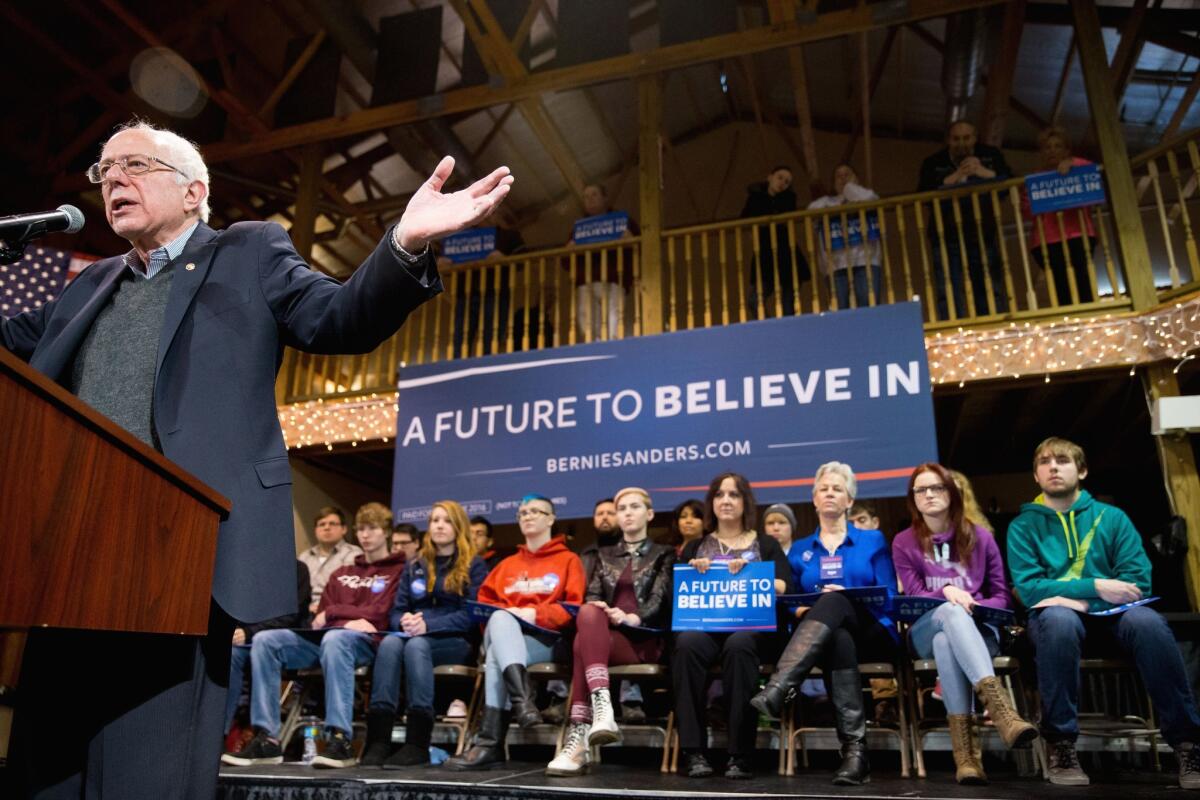Column: The dream of Medicare for all: Here’s why the Sanders health plan is more hope than change

Democratic presidential candidate Sen. Bernie Sanders (I-Vt.), speaking Tuesday, days after unveiling a plan for single-payer healthcare reform.
Otto von Bismarck’s famous definition of politics as “the art of the possible” gives us a good assessment of the single-payer health proposal unveiled by Democratic presidential candidate Bernie Sanders on Sunday: impossible.
That’s not to say that the “Medicare for All” plan offered by Sen. Sanders (I-Vt.) is worthless. Quite the contrary. As an aspirational document it serves the valuable purpose of placing single-payer healthcare firmly in the forefront of our political debate. A single-payer system like the one Sanders envisioned is impossible today in part because it’s routinely dismissed as impossible. By making the proposal a centerpiece of his Democratic primary campaign, Sanders has begun the process of stripping single-payer of its image as a pipe dream.
Imagine the national policy debate over abortion, contraception, HIV prevention, immigration policy, and other matters in a national Medicare plan.
— Healthcare expert Harold Pollack
But it’s only a start, and a halting one at best, because Sanders isn’t candid about the reasons single-payer is a difficult goal for American reformers today or about the immense difficulties of managing a single-payer system even if it could be enacted. These difficulties aren’t solely the result of profiteering by insurance companies or opposition from vested interests, as Sanders implies. They also arise from Americans’ deeply held thoughts about healthcare rights and political goals, and from the political structure that exists today. As Larry Levitt of the Kaiser Family Foundation remarked on Twitter, “It’s very hard to analyze Sen. Sanders’ health plan, because you have to imagine a political environment in which it could actually pass.”
Before examining a few examples, let’s outline the Sanders plan. His federally administered program would “cover the entire continuum of health care, from inpatient to outpatient care; preventive to emergency care; primary care to specialty care,” plus vision, hearing, and oral care and prescription drugs. Patients would show their Medicare card to the doctor of their choice -- no more networks -- and receive treatment with no more deductibles or co-pays. “No more fighting with insurance companies when they fail to pay for charges,” the Sanders plan says.
Sanders attributes the high cost of healthcare in the U.S. to two main features: the role of private insurers and the inability of government agencies to negotiate prices, especially with pharmaceutical companies. He would eliminate both obstacles to cost control, saving $6 trillion over 10 years, compared to the current system. The annual healthcare costs for a sample family of four with $50,000 in household income would fall to $466 a year from nearly $6,300 in current premiums and deductibles.
The program would cost $1.38 trillion a year, financed by converting today’s flow of premiums, co-pays, and tax breaks into an employer tax of 6.2%, household tax of 2.2%, higher income taxes on income of $250,000 and above and on capital gains and dividends, and the elimination of tax breaks for the rich.
Obviously the political obstacles to these financial arrangements alone would be massive. Sanders’ typical $50,000 family is right at the median of U.S. income, but the half of all taxpayers who earn more have a disproportionate political voice, and they won’t like this. Even if the higher taxes make up for premiums and other outlays dollar-for-dollar (and it’s not clear they would), the Sanders plan shifts the responsibility for paying for healthcare sharply upward on the income scale. Raising taxes on the wealthy is a superhuman feat.
But even in a world where a President Sanders is backed up by a resolutely progressive Congress, the transformation he envisions is nowhere near as simple as he asserts.
Does Sanders really intend to cover every conceivable treatment sought by American patients, as his plan implies? That’s a formula for an explosion in healthcare spending, with little indication it will lead to better health.
To at least a certain extent, insurers rejecting claims or treatments impose a limit on rising costs by demanding some evidence of cost-effectiveness. It’s an imperfect process, certainly, and hard to distinguish from mere profit-seeking, but it would have to be replaced by a government-administered version.
Americans almost certainly aren’t prepared to have the government rather than insurance companies saying “no.” In countries such as Britain, an entire bureaucracy, known as the National Institute for Health and Care Excellence, or NICE, exists to set limits on spending, rejecting treatments judged to be not worth the money. The process isn’t always pretty and often politically charged.
Telling cancer or cardiac sufferers that they can’t have a supposed wonder drug because it won’t extend their lives by enough per dollar of cost will be difficult enough. What about areas where medical policy conflicts with religious or moral scruples? As healthcare policy expert Harold Pollack wrote last year, “Imagine the national policy debate over abortion, contraception, HIV prevention, immigration policy, and other matters in a national Medicare plan.”
Pollack points to myriad other disruptions that would make healthcare even more of a political football than it is today. “We would require new care models for complex patients,” he observed. “We would face the economic, organizational, and human challenges of end-of-life care. We would make difficult decisions about network adequacy and patient cost sharing and face difficult questions in designing essential health benefit provisions for autism, substance use disorders, and cancer. ... We would face our society’s tenuous commitment to the well-being of our most disadvantaged citizens.”
Every major government reform produces winners and losers. That would be true in the healthcare transformation envisioned by Sanders. The losers would be health insurers; doctors, hospitals and drugmakers facing government price-cutting; and employees with company health plans subsidized by tax breaks. They would be richer and far better organized than the winners, who would include middle- and working-class families.
These are among the realities that killed healthcare reform campaigns going as far back as the Truman administration and animate the continued attacks on the Affordable Care Act. For years, U.S. politicians have nurtured an anti-government mood among voters; that mood was exploited by well-financed and well-organized opponents of a California single-payer initiative in 1994, resulting in its overwhelming defeat -- and it has only become more intense.
There’s no question that single-payer is “the only logical solution” to America’s fractured healthcare system, as the late healthcare expert Arnold S. Relman told me in 2013. But he understood that achieving the goal would be “a slow and painful process.”
The Affordable Care Act is potentially the first step in that process. But throwing it out and starting over with a single-payer reform, as Sanders proposes, won’t work. The result would be no Obamacare and no reform. That’s the goal of the ACA’s opponents on the right, but while Sanders has a more inclusive and more just goal in mind, his good intentions won’t help him achieve it.
The Affordable Care Act’s flaws and inadequacies resulted from the compromises necessary to get it passed at all. What’s most striking about the Sanders plan is that he more or less wishes those compromises away or covers them with magic asterisks. But they haven’t gone away. Any healthcare reform plan will have to confront them, and Sanders’ plan will intensify them.
Sanders has done a great public service in putting single-payer up for debate in the heat of a Presidential campaign. But his plan evokes the other part of Bismarck’s adage, which is that politics is also “the art of the next best.” At this stage in the maturity of America’s debate on healthcare reform, the Affordable Care Act is the next best thing to single-payer. It may be years before the next step can happen.
Keep up to date with Michael Hiltzik. Follow @hiltzikm on Twitter, see our Facebook page, or email michael.hiltzik@latimes.com.
More to Read
Inside the business of entertainment
The Wide Shot brings you news, analysis and insights on everything from streaming wars to production — and what it all means for the future.
You may occasionally receive promotional content from the Los Angeles Times.











